
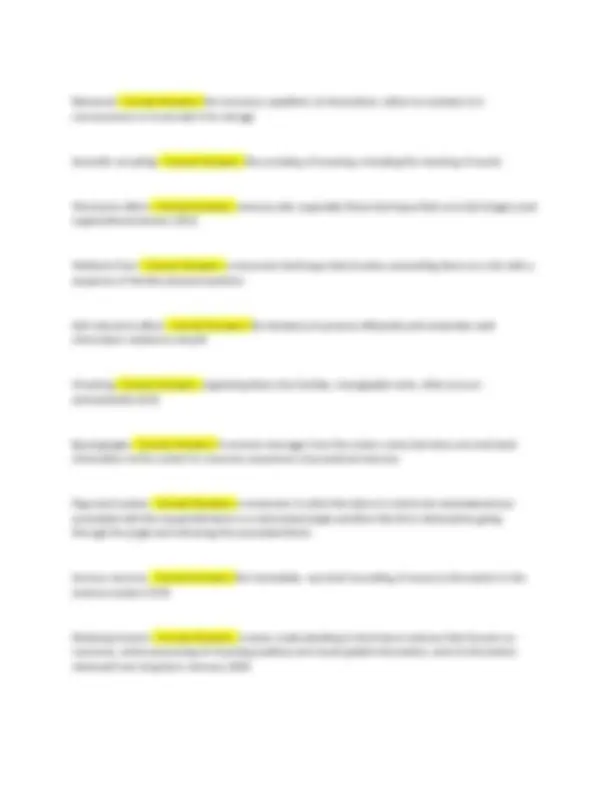
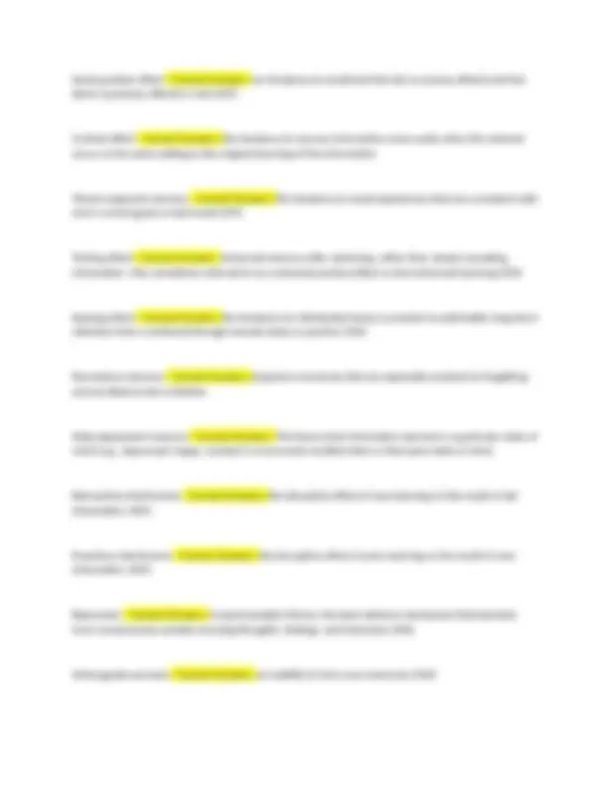
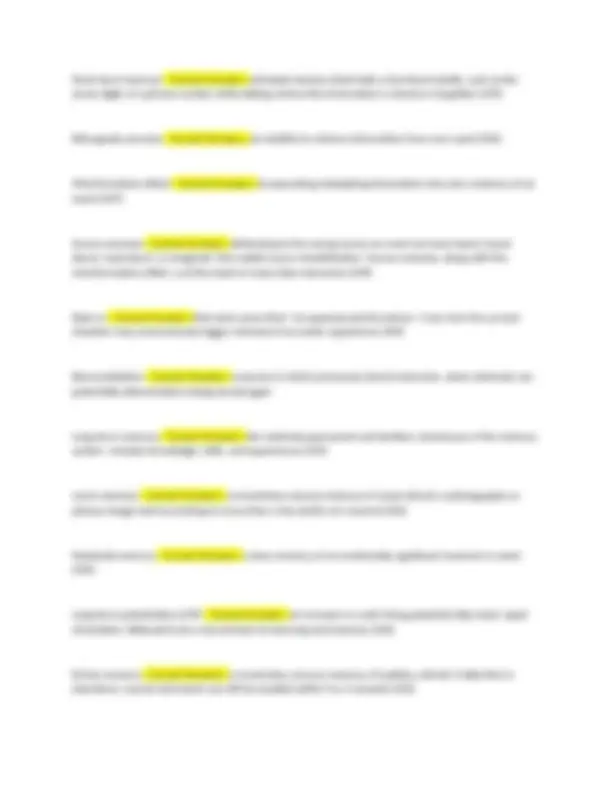
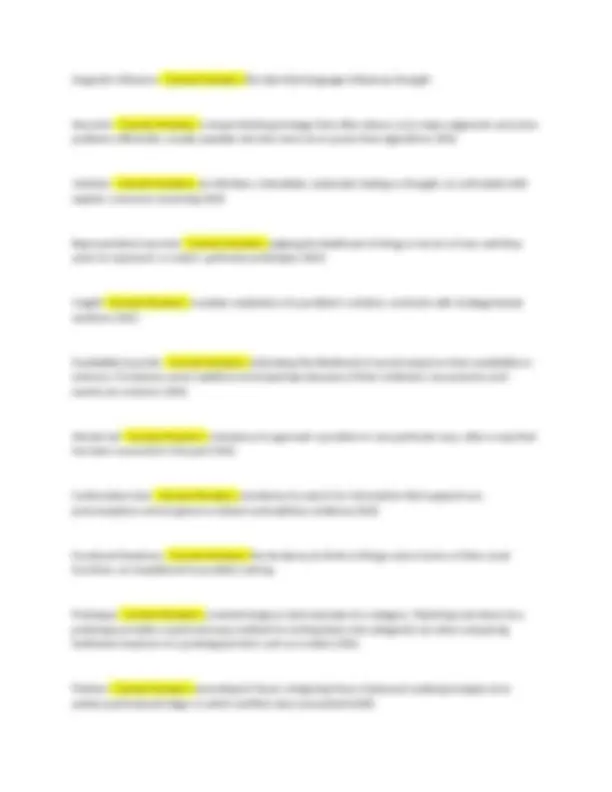
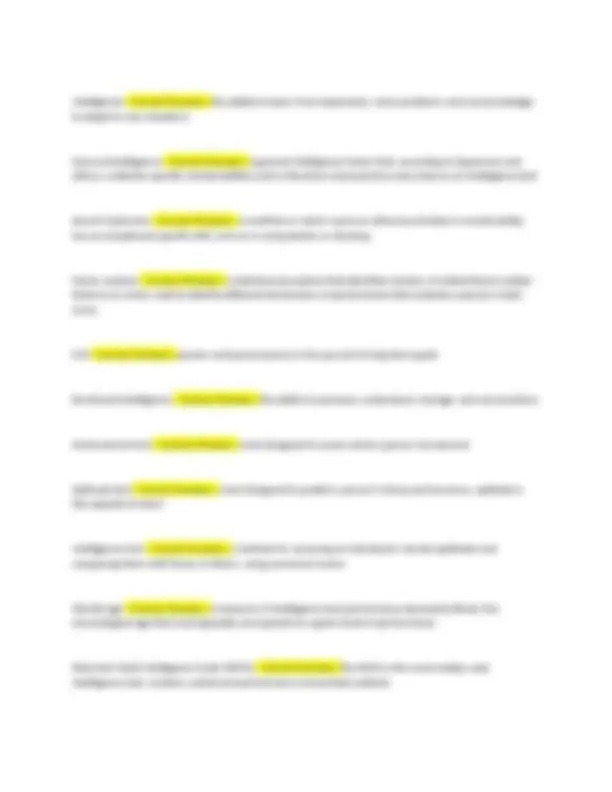
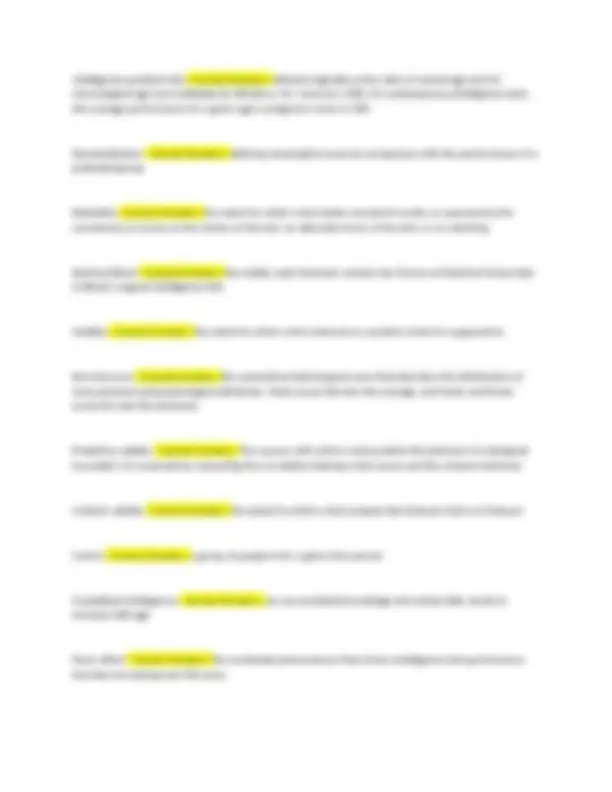


Study with the several resources on Docsity

Earn points by helping other students or get them with a premium plan


Prepare for your exams
Study with the several resources on Docsity

Earn points to download
Earn points by helping other students or get them with a premium plan
Community
Ask the community for help and clear up your study doubts
Discover the best universities in your country according to Docsity users
Free resources
Download our free guides on studying techniques, anxiety management strategies, and thesis advice from Docsity tutors
A comprehensive overview of key concepts in cognitive psychology, focusing on memory and cognitive abilities. It defines and explains various aspects of memory, including encoding, storage, retrieval, and different types of memory, such as sensory memory, working memory, and long-term memory. It also explores cognitive abilities, including problem-solving, thinking, and language. A valuable resource for students studying cognitive psychology, providing clear and concise definitions and explanations of important concepts.
Typology: Exams
1 / 11

This page cannot be seen from the preview
Don't miss anything!







[COMPANY NAME] [Company address]
Memory - Correct Answers: the persistence of learning over time through encoding, storage, and retrieval of information (Myers 318) Encoding - Correct Answers: the processing of information into the memory system--for example, by extracting meaning (319) Storage - Correct Answers: the process of retaining encoded information over time (319) Retrieval - Correct Answers: the process of getting information out of memory storage (319) Parallel processing - Correct Answers: the processing of many aspects of a problem simultaneously; the brain's natural mode of information processing for many functions. Contrasts with the step-by-step (Serial) processing of most computers and of conscious problem solving (319) Effortful processing - Correct Answers: encoding that requires attention and conscious effort (320) Shallow processing - Correct Answers: encoding on a basic level based on the structure or appearance of words (324) Deep processing - Correct Answers: encoding semantically, based on the meaning of the words; tends to yield the best retention (325) Hippocampus - Correct Answers: a neural center located in the limbic system; helps process explicit memories for storage (330) Selective attention - Correct Answers: the focussing of conscious awareness on a particular stimulus (152) Automatic processing - Correct Answers: unconscious encoding of incidental information, such as space, time, and frequency, and of well-learned information, such as word meanings (320) Overlearning - Correct Answers: additional rehearsal of information leads to increased retention
Serial position effect - Correct Answers: our tendency to recall best the last (a recency effect) and first items (a primacy effect) in a list (337) Context effect - Correct Answers: the tendency to recover information more easily when the retrieval occurs in the same setting as the original learning of the information Mood-congruent memory - Correct Answers: the tendency to recall experiences that are consistent with one's current good or bad mood (337) Testing effect - Correct Answers: enhanced memory after retrieving, rather than simply rereading, information. Also sometimes referred to as a retrieval practice effect or test-enhanced learning (324) Spacing effect - Correct Answers: the tendency for distributed study or practice to yield better long-term retention than is achieved through massed study or practice (324) Permastore memory - Correct Answers: long-term memories that are especially resistant to forgetting and are likely to last a lifetime State-dependent memory - Correct Answers: The theory that information learned in a particular state of mind (e.g., depressed, happy, somber) is more easily recalled when in that same state of mind. Retroactive interference - Correct Answers: the disruptive effect of new learning on the recall of old information (345) Proactive interference - Correct Answers: the disruptive effect of prior learning on the recall of new information (345) Repression - Correct Answers: in psychoanalytic theory, the basic defense mechanism that banishes from consciousness anxiety-arousing thoughts, feelings, and memories (346) Anterograde amnesia - Correct Answers: an inability to form new memories (342)
Short-term memory - Correct Answers: activated memory that holds a few items briefly, such as the seven digits of a phone number while dialing, before the information is stored or forgotten (319) Retrograde amnesia - Correct Answers: an inability to retrieve information from one's past (342) Misinformation effect - Correct Answers: incorporating misleading information into one's memory of an event (347) Source amnesia - Correct Answers: attributing to the wrong source an event we have heard, heard about, read about, or imagined. Also called source misattribution. Source amnesia, along with the misinformation effect, is at the heart of many false memories (349) Déjà vu - Correct Answers: that eerie sense that 'I've experienced this before.' Cues from the current situation may unconsciously trigger retrieval of an earlier experience (349) Reconsolidation - Correct Answers: a process in which previously stored memories, when retrieved, are potentially altered before being stored again Long-term memory - Correct Answers: the relatively permanent and limitless storehouse of the memory system. Includes knowledge, skills, and experiences (319) Iconic memory - Correct Answers: a momentary sensory memory of visual stimuli; a photographic or picture-image memory lasting no more than a few tenths of a second (322) Flashbulb memory - Correct Answers: a clear memory of an emotionally significant moment or event (332) Long-term potentiation (LTP) - Correct Answers: an increase in a cell's firing potential after brief, rapid stimulation. Believed to be a neural basis for learning and memory (333) Echoic memory - Correct Answers: a momentary sensory memory of auditory stimuli; if attention is elsewhere, sounds and words can still be recalled within 3 or 4 seconds (322)
Overconfidence - Correct Answers: the tendency to be more confident than correct—to overestimate the accuracy of our beliefs and judgments (365) Belief perseverance - Correct Answers: clinging to one's initial conceptions after the basis on which they were formed has been discredited (367) Framing - Correct Answers: the way an issue is posed; how an issue is framed can significantly affect decisions and judgments (368) Concept - Correct Answers: a mental grouping of similar objects, events, ideas, or people (356) Morpheme - Correct Answers: in a language, the smallest unit that carries meaning; may be a word or a part of a word (such as a prefix) (373) Phoneme - Correct Answers: in language, the smallest distinctive sound unit (373) Syntax - Correct Answers: The arrangement of words and phrases to create well-formed sentences in a language. Aphasia - Correct Answers: impairment of language, usually caused by left hemisphere damage either to Broca's area (impairing speaking) or to Wernicke's area (impairing understanding) (377) Grammar - Correct Answers: in a language, a system of rules that enables us to communicate with and understand others. IN a given language, semantics is the set of rules for deriving meaning from sounds, and syntax is the set of rules for combining words into gramatically sensible sentences (#73) Linguistic determinism - Correct Answers: Whorf's hypothesis that language determines the way we think (379) Algorithm - Correct Answers: a methodical, logical rule or procedure that guarantees solving a particular problem. Contrasts with the usually speedier--but also more error-prone--use of heuristics (361)
Linguistic influence - Correct Answers: the idea that language influences thought Heuristic - Correct Answers: a simple thinking strategy that often allows us to make judgments and solve problems efficiently; usually speedier but also more error-prone than algorithms (361) Intuition - Correct Answers: an effortless, immediate, automatic feeling or thought, as contrasted with explicit, conscious reasoning (363) Representative heuristic - Correct Answers: judging the likelihood of things in terms of how well they seem to represent, or match, particular prototypes (364) Insight - Correct Answers: a sudden realization of a problem's solution; contrasts with strategy-based solutions (361) Availability heuristic - Correct Answers: estimating the likelihood of events based on their availability in memory; if instances come readily to mind (perhaps because of their vividness), we presume such events are common (364) Mental set - Correct Answers: a tendency to approach a problem in one particular way, often a way that has been successful in the past (362) Confirmation bias - Correct Answers: a tendency to search for information that supports our preconceptions and to ignore or distort contradictory evidence (362) Functional fixedness - Correct Answers: the tendency to think of things only in terms of their usual functions; an impediment to problem solving Prototype - Correct Answers: a mental image or best example of a category. Matching new items to a prototype provides a quick and easy method for sorting items into categories (as when comparing feathered creatures to a prototypical bird, such as a robin) (356) Fixation - Correct Answers: according to Freud, a lingering focus of pleasure-seeking energies at an earlier psychosexual stage, in which conflicts were unresolved (560)
Intelligence quotient (IQ) - Correct Answers: defined originally as the ratio of mental age (ma) to chronological age (ca) multiplied by 100 [thus, IQ = (ma/ca) x 100]. On contemporary intelligence tests, the average performance for a given age is assigned a score of 100. Standardization - Correct Answers: defining meaningful scores by comparison with the performance of a pretested group Reliability - Correct Answers: the extent to which a test yields consistent results, as assessed by the consistency of scores on two halves of the test, on alternate forms of the test, or on retesting Stanford Binet - Correct Answers: the widely used American revision (by Terman at Stanford University) of Binet's original intelligence test. Validity - Correct Answers: the extent to which a test measures or predicts what it is supposed to Normal curve - Correct Answers: the symmetrical bell-shaped curve that describes the distribution of many physical and psychological attributes. Most scores fall near the average, and fewer and fewer scores lie near the extremes. Predictive validity - Correct Answers: The success with which a test predicts the behavior it is designed to predict; it is assessed by computing the correlation between test scores and the criterion behavior. Content validity - Correct Answers: the extent to which a test samples the behavior that is of interest Cohort - Correct Answers: a group of people from a given time period Crystallized intelligence - Correct Answers: our accumulated knowledge and verbal skills; tends to increase with age Flynn effect - Correct Answers: the worldwide phenomenon that shows intelligence test performance has been increasing over the years
Fluid intelligence - Correct Answers: our ability to reason speedily and abstractly; tends to decrease during late adulthood Down Syndrome - Correct Answers: a condition of intellectual disability and associated physical disorders caused by an extra copy of chromosome 21. Intellectual disability - Correct Answers: a condition of limited mental ability, indicated by an intelligence score of 70 or below and difficulty in adapting to the demands of life; varies from mild to profound Heritability - Correct Answers: The proportion of variation among individuals that we can attribute to genes. The heritability of a trait may vary, depending on the range of populations and environments studied. Mental rotation test - Correct Answers: a test of spatial abilities Stereotype threat - Correct Answers: a self-confirming concern that one will be evaluated based on a negative stereotype